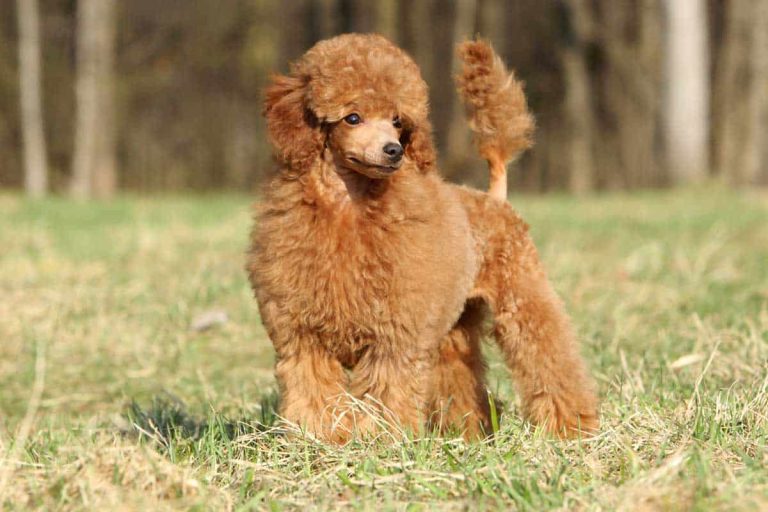This post may contain affiliate links. We may earn money or products from the companies mentioned in this post.
If you are looking for a new dog and the toy poodle has caught your eye with its adorable head tilts, then you may be wondering: how long do toy poodles live?
Fortunately, as a small dog breed, the toy poodle has an impressive lifespan of 15 to 18 years.
With excellent care and a bit of genetic luck, a toy poodle can sometimes live for up to 22 years old.
There are a number of factors that can contribute to that excellent care, such as good nutrition, consistent grooming, and plenty of exercise.

Unfortunately, on the flip side of the lifespan coin, there are also a number of factors that can shorten your toy poodle’s lifespan, such as a poor diet, neglect, breed-specific health concerns, and poor quality care in general.
In this article, I will look at what positively and negatively impacts a toy poodle’s lifespan as well as why small dogs like them live so long.
Toy Poodle: Main Breed Characteristics
- Breed Name: Toy poodle
- Height: Maximum 10 inches
- Weight: 4 to 6 pounds
- Average Lifespan: 15 to 18 years
- Coat Color: Apricot, black, blue, brown, café au lait, cream, gray, red, silver, silver-beige, white
Key Characteristics: Intelligent, athletic, good with people and children, average with other dogs, low shedding, low-allergen coat, friendly, vocal, easily trained
What Is A Toy Poodle?
The standard poodle was originally bred in the 1600s in France to be the ultimate water-retrieving hunting dog.
Poodles would accompany water bird hunters on their trips and bring back a bird after it was shot.
They were bred to be excellent swimmers, fast runners, and incredibly intelligent.
Their coat was bred to protect their joints and organs from the freezing cold of the icy European winter water.
As a happy accident, their coat also happens to be very close to completely hypoallergenic.
The French nobility loved the look and intelligence of the dog so much, they wanted it pocket-sized; as a result, the breeding process for a tiny version of the standard poodle began.
The miniature poodle became a fashionable accessory to have that fit perfectly on the laps of rich women.
Miniature poodles were so intelligent and easy to train to do tricks, they were often trained to perform in the circus and entertain the European nobility.
The toy poodle as we know it today was later bred in America in the 1900s to be an intelligent, friendly, and small companion dog that could fit comfortably in apartments and condos.
The toy poodle is a shrunken-down replica of the standard poodle. It is an excellent swimmer, a fast runner, and incredibly agile and athletic.
What’s more, it has the same beautiful (almost completely hypoallergenic) coat and is as intelligent as its larger counterparts.
How Long Do Toy Poodles Live For?
In general, Toy poodles enjoy long lives. Their average lifespan ranges from 15 to 18 years.
However, if they receive excellent and consistent care from puppyhood into their old age, they can make it into their 20s.
However, there are many important factors that can either positively or negatively impact the lifespan of a toy poodle, and it is up to the dog’s owner to ensure they do everything they can to provide their toy poodle with the best quality of life possible.
What Positively Impacts A Toy Poodle’s Lifespan?
While you can’t extend your toy poodle’s life beyond what it was meant to be as determined by their genetics, you can do everything in your power to ensure your toy poodle lives a happy and healthy life within their normal lifespan.
Good Nutrition
Balanced, quality nutrition is an important part of any animal’s life. Toy poodles are no different.
Getting that good nutrition from the time your toy poodle is a puppy is essential.
Healthy and strong bones, joints, muscles, and organs are all developed in the first few years of your pup’s life and maintained thereafter.
This is why it is crucial to provide your toy poodle with proper nutrition from the time they are weaned from their mother’s milk.
Toy poodles are very active and energetic, which means they put a fair amount of wear and tear on their joints.
Enhancing their diet with joint support supplements such as glucosamine, chondroitin, and MSM can help to protect your dog’s joints as they get older.
Consistent Grooming
Coat
Toy poodles do not shed a lot, which means they are low-allergen dogs. They are as close as you will get to a completely hypoallergenic dog.
However, this does not mean their grooming needs diminish.
Your toy poodle’s coat needs to be brushed at least once a week (or more if it gets wet). If your toy poodle’s coat is left wet and unbrushed, it will start to naturally cord.
This is not necessarily a bad thing; however, it does mean they will need additional care for their corded coat.
Many people choose to keep their toy poodles shaved in the elaborate show style (continental or English saddle clip) or the more manageable sporting clip.
These clips/styles are designed to show off the dog’s features and to protect their organs and joints from cold water.
If your toy poodle’s coat is left ungroomed, it can become compacted and develop large, painful mats.
These mats pull on the skin and can cause hair loss and open wounds and create a breeding ground for infection-causing bacteria.
Ears And Teeth
The toy poodle’s grooming needs go beyond just its luxurious coat.
Toy poodles have long, floppy ears that collect dirt easily. They will need to be cleaned every second or third day to avoid bacteria build-up and infection.
Your toy poodle should also have its teeth brushed every week to avoid plaque buildup, receding gums, and tooth decay, all of which can cause infections and shorten their lifespan.
Plenty Of Physical And Mental Exercise
Toy poodles have not forgotten why their ancestors were bred: to be agile, athletic, and active.
Your toy poodle may be tiny, but it is mighty and needs a mighty amount of mental and physical exercise to stay healthy and live a long life.
Physical Exercise
Physical exercise performs the same function for dogs as it does for humans.
It’s essential for maintaining a healthy heart, building muscles to support and protect the joints, and preventing obesity.
Your toy poodle should have a minimum of an hour of active physical exercise a day.
They need this physical exercise to maintain their bodies and heart health to promote a long and healthy life.
They also need this physical exercise to blow off steam, especially if they are kept in an apartment or condo all day.
Without enough physical exercise, your toy poodle will become destructive and needy and bark your neighbors into oblivion.
Physical exercise can take a number of forms:
- Going for a walk
- Playing with a ball or toy that encourages movement
- Playing with other dogs
- Running around with children
- Going for a swim
Mental Exercise
Physical exercise is not the only form of exercise that is necessary for toy poodles to be engaged in.
Your toy poodle is very intelligent and needs to be mentally stimulated. Without mental engagement, your dog will become bored and destructive.
The boredom can add to feelings of doggy depression and anxiety and losing interest in food and the world around them.
This kind of mental state affects dogs as much as it affects humans and can be as effective at shortening their lifespan as any physical disease.
Using a slow feeder bowl and other interactive feeding methods can provide daily mental stimulation for your toy poodle that doesn’t require extra time or effort from you.
This small change can lead to a huge difference for your dog.
Other forms of mental exercise:
- Puzzles
- Daily training
- Teaching tricks
- Obstacles
Yearly Vet Visits
Your toy poodle’s yearly vet check up is a very important factor in positively impacting your pup’s lifespan.
While going to the vet doesn’t exactly make your dog any healthier, your vet can do early detection tests and provide preventative or supplemental care for issues that may arise later in life.
Things like cancer detection, diabetes detection, and addressing nutrition deficiencies are all things your vet will do for you and your pup to ensure they are as healthy as possible.
If your toy poodle is diagnosed with an illness early on without much disease progression, then they will receive the care they need and can still live a happy and long life well within their expected lifespan.
What Negatively Impacts A Toy Poodle’s Lifespan?
Unfortunately, there are also many things that can negatively impact and reduce your toy poodle’s lifespan.
Apart from the obvious things like accidents and unpredicted disease, certain lifestyle choices can ultimately reduce the time you have with your toy poodle.
Poor Care
Receiving poor care at key developmental stages in their life can greatly reduce your toy poodle’s lifespan.
As I mentioned above, good nutrition during the growing stages of your toy poodle’s life is essential; in addition to good nutrition, your toy poodle needs a safe and stable environment.
If your toy poodle did not receive sufficient nutrition during this vital time, they may experience stunted growth or deformities in their organs that can limit their lifespan.
If the environment they grew up in is full of anxiety and fear, they may also suffer from a shortened lifespan.
As your toy poodle grows older, they need care to support their aging bodies.
Without this additional care, they can suffer from things like bone disease and heart failure, which can drastically reduce their potential lifespan.
Lack Of Exercise
As I mentioned earlier, exercise is incredibly important for toy poodles.
Many toy breeds commonly suffer from obesity, including the toy poodle, and exercise is the best way to prevent it and ensure your dog has a long lifespan.
It is easy to overindulge the adorable toy poodle; many owners feed their dogs from the table and give them plenty of treats that are high in fat.
Toy poodles also do not always get enough exercise due to their small size.
However, this overindulgence and lack of exercise leads to obesity, which shortens their lifespan.
Common Breed-Specific Health Problems
Although they are mostly healthy and quite hardy, as with most breeds, toy poodles suffer from some common health issues.
Be on the lookout for:
- Hip dysplasia
- Luxating patella
- Legg-Calve-Perthes
- Von Willebrand’s disease
- Idiopathic epilepsy
- Sebaceous adenitis
With early detection and proper treatment, these issues do not shorten a dog’s lifespan.
However, if they are left untreated or complications arise, then your toy poodle’s lifespan may be affected.
Genetic diversity by mixing breeds or only using a reputable breeder is key to avoiding these common breed-specific health problems.
FAQs About Toy Poodle Lifespans…
How long do standard poodles and miniature poodles live for?
Standard poodles are the largest of the three poodles. They live for 10 to 12 years on average.
Miniature poodles were the first variation from standard poodles and enjoy a slightly longer lifespan of 12 to 15 years on average
The same positive and negative factors that affect the toy poodle affect the standard and miniature, too.
Why do small dogs live longer than larger dogs?
Toy dog breeds live longer than large and giant dog breeds.
To put it simply, larger dog breeds have larger bodies to maintain, which expends more energy and shortens their lifespan when compared to smaller breeds.
As a result, larger dog breeds typically live for 7 to 12 years on average instead of the staggering 18 to 22 years that can be typical of small and toy breeds.
Rolling Over On How Long Toy Poodles Live For…
Toy poodles live for 15 to 18 years on average. However, with consistent good care, plenty of exercise, and lots of love, your toy poodle can enter its 20s quite comfortably.
To recap, let’s look at the main characteristics of toy poodles:
- Breed Name: Toy poodle
- Height: Maximum 10 inches
- Weight: 4 to 6 pounds
- Average Lifespan: 15 to 18 years
- Coat Color: Apricot, black, blue, brown, café au lait, cream, gray, red, silver, silver beige, white
- Key Characteristics: Intelligent, athletic, good with people and children, average with other dogs, little shedding, low-allergen coat, friendly, vocal, easily trained
Keeping your toy poodle physically and mentally exercised everyday, getting yearly check-ups at the vet, providing them with good nutrition, and being consistent with their care all go a long way to ensuring your toy poodle lives a long and healthy life.
Do you have a toy poodle?
Tell us about your experiences in the comment section below.
Save To Pinterest

Top Picks For Our Puppies
- BEST PUPPY TOY
We Like: Calmeroos Puppy Toy w/ Heartbeat and Heat Packs – Perfect for new puppies. Helps ease anxiety in their new home. - BEST DOG CHEW
We Like: Bones & Chews Bully Sticks – All of our puppies love to bite, nip, and chew. We love using Bully Sticks to help divert these unwanted behaviors. - BEST DOG TREATS
We Like: Crazy Dog Train-Me Treats – We use these as our high-value treats for our guide dog puppies. - BEST FRESH DOG FOOD
We Like: The Farmer’s Dog – A couple months ago we started feeding Raven fresh dog food and she loves it! Get 50% off your first order of The Farmer’s Dog.
Check out more of our favorites on our New Puppy Checklist.























